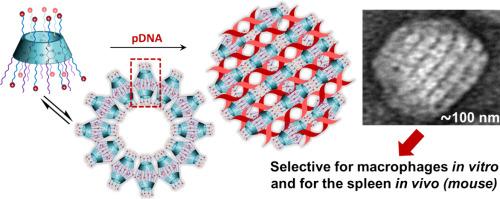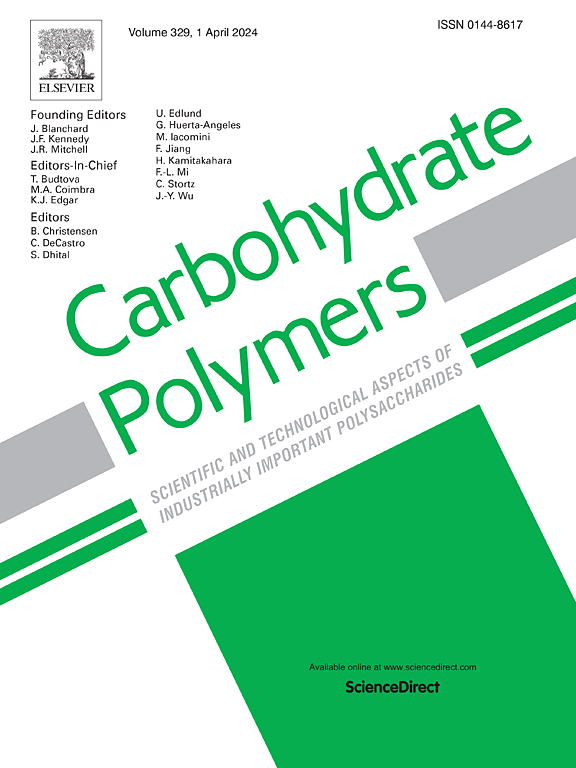β-Cyclodextrin-based geometrically frustrated amphiphiles as one-component, cell-specific and organ-specific nucleic acid delivery systems
IF 10.7
1区 化学
Q1 CHEMISTRY, APPLIED
引用次数: 0
Abstract
We introduce an innovative β-cyclodextrin (βCD)-prototype for delivering nucleic acids: “geometrically frustrated amphiphiles (GFAs).” GFAs are designed with cationic centers evenly distributed across the primary O6 and secondary O2 positions of the βCD scaffold, while hydrophobic tails are anchored at the seven O3 positions. Such distribution of functional elements differs from Janus-type architectures and enlarges the capacity for accessing strictly monodisperse variants. Changes at the molecular level can then be correlated with preferred self-assembly and plasmid DNA (pDNA) co-assembly behaviors. Specifically, GFAs undergo pH-dependent transition between bilayered to monolayered vesicles or individual molecules. GFA-pDNA nanocomplexes exhibit topological and internal order characteristics that are also a function of the GFA molecular architecture. Notably, adjusting the pKa of the cationic heads and the hydrophilic-hydrophobic balance, pupa-like arrangements implying axial alignments of GFA units flanked by quasi-parallel pDNA segments are preferred. In vitro cell transfection studies revealed remarkable differences in relative performances, which corresponded to distinct organ targeting outcomes in vivo. This allowed for preferential delivery to the liver and lung, kidney or spleen. The results collectively highlight cyclodextrin-based GFAs as a promising class of molecular vectors capable of finely tuning cell and organ transfection selectivity.

基于β-环糊精的几何失谐双亲化合物作为单组分、细胞特异性和器官特异性核酸递送系统
我们介绍了一种用于递送核酸的创新型β-环糊精(βCD)原型:"几何挫折双亲化合物(GFAs)"。在设计 GFAs 时,阳离子中心均匀分布在 βCD 支架的一级 O6 和二级 O2 位置上,而疏水尾则固定在七个 O3 位置上。功能元素的这种分布不同于 Janus 型结构,它提高了获得严格单分散变体的能力。分子水平的变化可与首选的自组装和质粒 DNA(pDNA)共组装行为相关联。具体来说,GFA 在双层到单层囊泡或单个分子之间会发生 pH 依赖性转变。GFA-pDNA纳米复合物表现出拓扑和内部秩序特征,这些特征也是GFA分子结构的函数。值得注意的是,调整阳离子头的 pKa 值和亲水-疏水平衡后,"蛹 "状排列意味着 GFA 单元轴向排列,两侧是准平行的 pDNA 片段。体外细胞转染研究揭示了相对性能的显著差异,这与体内不同器官的靶向结果相对应。这使得环糊精可以优先输送到肝脏、肺脏、肾脏或脾脏。这些结果共同凸显了基于环糊精的 GFAs 是一类很有前途的分子载体,能够精细调整细胞和器官转染的选择性。
本文章由计算机程序翻译,如有差异,请以英文原文为准。
求助全文
约1分钟内获得全文
求助全文
来源期刊

Carbohydrate Polymers
化学-高分子科学
CiteScore
22.40
自引率
8.00%
发文量
1286
审稿时长
47 days
期刊介绍:
Carbohydrate Polymers stands as a prominent journal in the glycoscience field, dedicated to exploring and harnessing the potential of polysaccharides with applications spanning bioenergy, bioplastics, biomaterials, biorefining, chemistry, drug delivery, food, health, nanotechnology, packaging, paper, pharmaceuticals, medicine, oil recovery, textiles, tissue engineering, wood, and various aspects of glycoscience.
The journal emphasizes the central role of well-characterized carbohydrate polymers, highlighting their significance as the primary focus rather than a peripheral topic. Each paper must prominently feature at least one named carbohydrate polymer, evident in both citation and title, with a commitment to innovative research that advances scientific knowledge.
 求助内容:
求助内容: 应助结果提醒方式:
应助结果提醒方式:


